How often and correctly water onions?
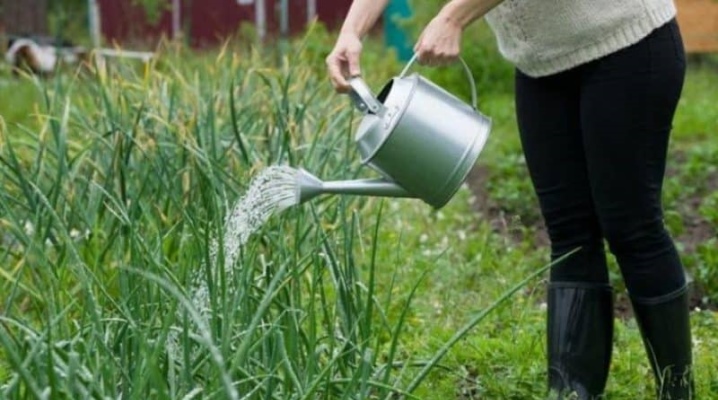
Green onions have always been a favorite staple on the table. It contains many vitamins and minerals, and this plant also has excellent taste. But without proper onion care, it is impossible to get healthy and tasty shoots, and watering is one of the most important steps in the care of almost any plant.

Water requirements
In order to bring maximum benefit to the plant, the best solution would be to take slightly warm, settled water... If you water the onion with cold water or from the tap, then due to the sharp contrast in temperature, it will be stressed all the time - this is the reason for the poor growth of the crop.
It is important that the water has settled to room temperature. (not less than 14-18 degrees Celsius) early (in the evening, if a person is going to arrange watering in the morning, or, conversely, when the sun rises for evening watering). For this purpose, it is necessary to fill any container with water (for example, a can, a barrel, a bath, and others) and leave it for a while.
Very warm or, even worse, hot water will not do any good either. Due to the increased temperature and humidity of the air, excellent conditions are created for the development of rot on plants.
However, watering with water slightly above room temperature is needed in those few months when there is an active growth of green shoots and the formation of a bulb. After this period, the growth of the heads does not occur, and they begin to accumulate useful substances.
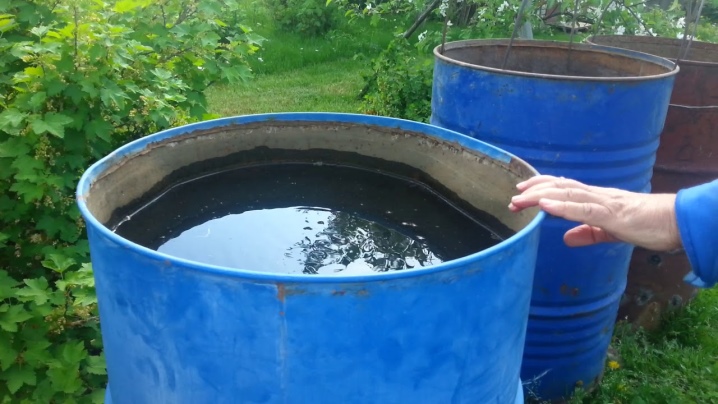
Is it better to water in the morning or evening?
Batun onions can be watered in the evening, preferably after eight or nine o'clock, or early in the morning, since it is not very hot at this time. Both methods will be correct.
During the day, during the heat, it is impossible to water the onion. Because of this, you can expose the plant to burns. This is because the water that gets on them looks like a very small lens. The light of the sun, falling on it, is refracted and leaves a burn on the sheet.
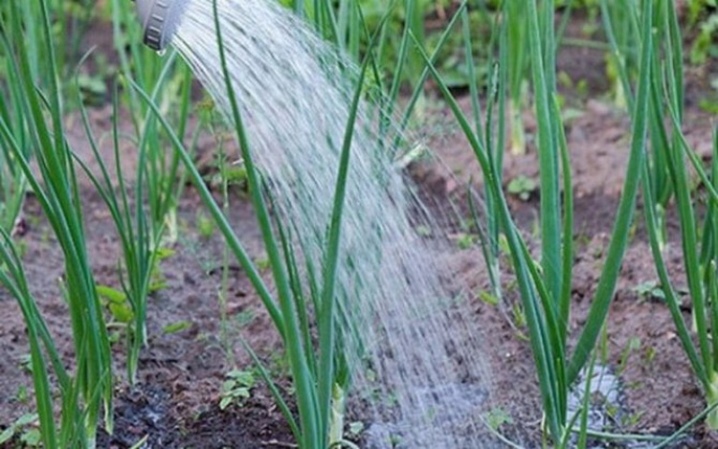
Watering rates and frequency
How often the land needs to be watered depends on the meteorological conditions. In areas where it rains all the time and the air humidity is high, there is no need to water the onions. Excess water will have a bad effect on the plant, can cause fungal diseases, as well as rotting of the bulb.
If the soil is not sufficiently moistened, then this will cause the onion to stop growing or develop poorly. After that, even intensive watering will hardly help the plant in any way. By the way, it is precisely such an injury for the plant that makes its taste bitter and very sharp, which, according to its characteristics, puts it next to wild varieties of onions.
It is necessary to water the plant with plenty of water. If we take as an example not very hot summer weather with a constant air temperature, then watering should be done several times a week and watering the onion until the soil next to it is completely wet.
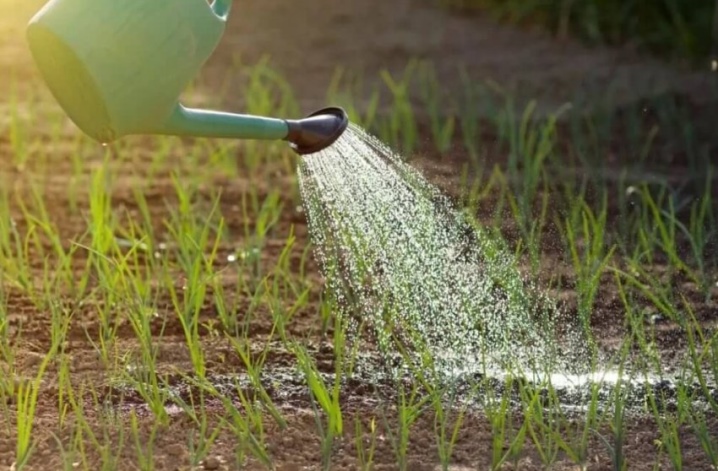
Whether there is a need to moisten the soil or whether you can leave it alone for a while can be checked experimentally. To do this, you need to grab a small handful of soil from a depth of ten to fifteen centimeters and squeeze with force, then unclench your fist. If, after these manipulations, large lumps of soil remain on the hand, this means that there is enough moisture. If the earth falls apart into small crumbs, then this indicates that the earth needs to be moistened.
There is another way that no longer requires the use of physical force. You will need to take an ordinary wooden stick, place it at a depth of fifteen to twenty centimeters, and then remove it. The pieces of soil remaining on it mean that there is no need to water. If the piece is dry and practically clean, you need to water the onion again.
On days when the sun is shining outside and the weather is sultry, the beds are watered five to six times a week. In this case, the earth needs to be well stocked with moisture (no less than fifteen to twenty centimeters deep).
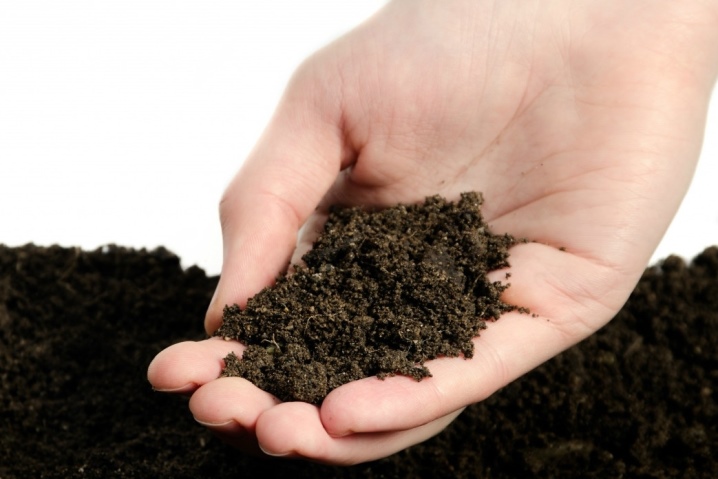
Also, the time of soil moisture depends on the growing season:
- immediately after the onions are planted in the ground, a whole bucket of water may be needed per square meter;
- when the first green shoots appear (period in late May or early June), this figure is raised to ten to twelve liters per square meter;
- in June, when the onion begins its active development, up to eight to ten liters per square meter are needed;
- during the period when the onion heads have already developed enough, the volume of water decreases by another two liters, a total of five to six liters per square meter;
- in the last month before harvesting, watering is stopped.
Watering must be done correctly: one to two weeks after planting and during the appearance of the first green shoots in the beds, you can water from a watering can. When the onion heads begin to develop, watering from above must be stopped, since the rapid water flow spoils the roots and there is even a danger that the head will appear from the soil.
Moisturizing onions outdoors is a necessary step to grow tasty and healthy onions. This method of growing is different from the greenhouse, in the second version, the humidity of the earth and air is easy to control.
In open areas, the earth dries out many times faster, since the heat of the sun and the force of the wind act on it.

After landing
Different types of planting require different care.
Onion sets - a young type of onion sprouted from cuttings. They are very small sized bulbs. This type of onion can be freely planted and grown with the help of seeds, or purchased in specialized stores.
In order for a high-quality plant to grow from a seed, you first need to choose good seeds. Small bulbs should be smooth, without sprouts, otherwise all trace elements and nutrients will go into the feathers, and some of them under the ground will not be tasty and not very useful. Before buying, it is important to pay attention to the presence of cracks or rot. This is an important factor, since this type of onion will not make a good head. She will have a much higher chance of getting sick, her growth and development will become inactive, and in the worst case, the onion will rot altogether.
A high-quality set is not very large, elastic, with an even and whole adherent skin.
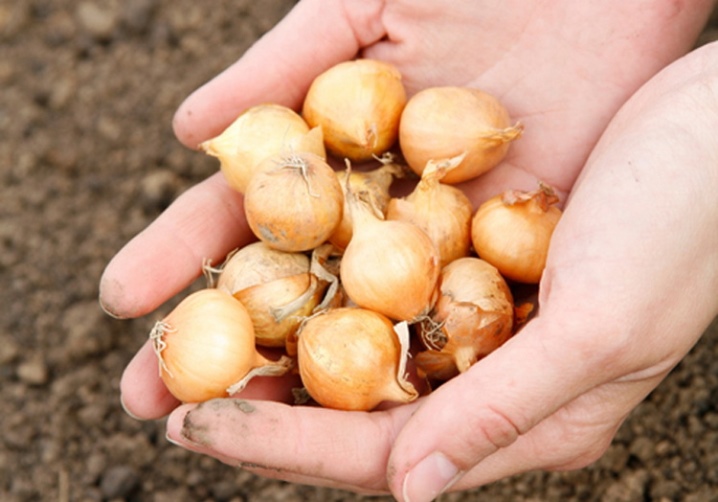
Bulbs are most often planted in May, there will never be an exact planting date, as it depends on the weather conditions of a particular area. Throughout Russia, it is customary to consider the end of spring to be the time for planting onions, because it is at this time that the soil is moistened, which is exactly what the plant loves.
Sevok is most often not watered, but planted in already moistened soil. This is to prevent the small bulbs from being washed away by the large stream of water. Thus, all the seeds remain in place, and the seedlings take root and are saturated with nutrients.
After the seed has taken root, the young plant is watered from a watering can. At this point in watering onions, it is important to keep midway between wet and dry and soil. In addition, it is necessary to understand that not only grass and flowers develop well in spring. During this period, harmful bacteria are also awakened.
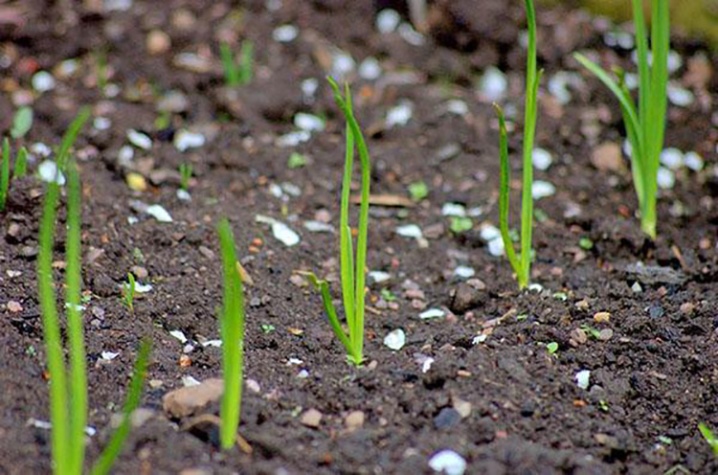
Planting onions is done in another way - on the turnip, or on the head.
For this, grooves are made, the depth of which does not exceed eight to ten centimeters, and the distance between them is more than fifteen centimeters.Then a mixture of phytosporin is poured onto them to remove fat from the surface. You can replace this solution with a loose mixture (powder), adding one teaspoon to ten liters of water, or a paste, diluting one tablespoon of this substance in ten liters of water.
Sevok is planted in the processed grooves, keeping a distance of ten centimeters from each other. Onions are planted, covering not only the roots. Sevok needs to be placed much further. These steps are designed to better bond the seed to the soil.
Further, the workpiece is covered with sawdust, they serve as a good fertilizer and do an excellent job of killing bacteria and microbes. Then comes the layer of earth.
Using this planting method, the onions are watered by drip or between rows. The water needs to penetrate to the depth of the bulb and provide the soil with moisture.

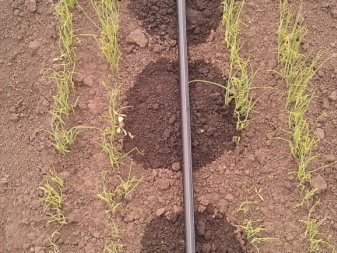
During the period of active growth and formation of the bulb
In June, the first green feathers begin to sprout. At this time, the frequency of watering depends on the meteorological conditions. For example, if there is no rain, then in the open air it is enough to moisten the soil once or twice a week, while in the greenhouse you can water it once every ten days.
In the future, when growing onions, it is recommended to pour water throughout the entire period of plant growth (if the onions are grown in greenhouse conditions, it is important to take into account the air temperature in the room). If the numbers on the thermometer exceed fifteen to twenty degrees Celsius, then watering is done very carefully. The average is three liters of water per square meter.
If in summer the temperature rises to twenty-five degrees Celsius or more, the frequency of soil enrichment with water increases, approximately once every four to five days, and the amount of liquid is three to four liters per square meter.
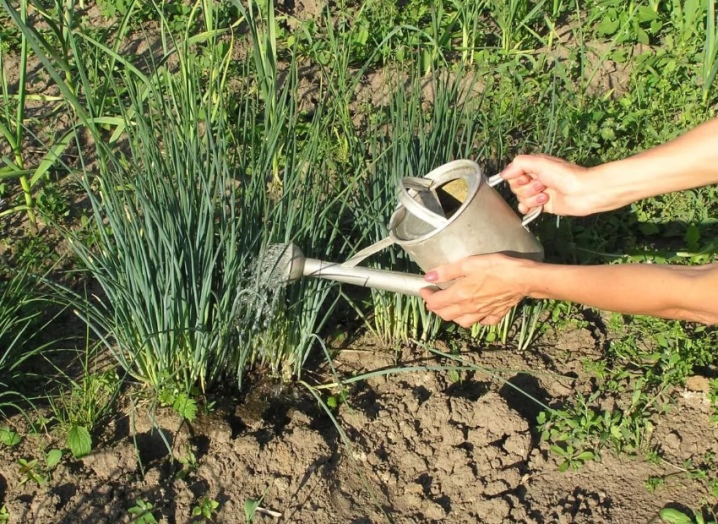
Before harvest
In the midst of onion growth (this occurs before harvesting), the frequency and volume of watering fluid is reduced or stopped altogether. At this point, greens are harvested, if necessary.
If the purpose of cultivation was the bulb itself, the plant is left until the feathers are completely dry. This is done so that all the necessary elements return from the tops to the root.
The purpose of irrigating an already grown onion is to keep the fully frolicking bulb free from excess moisture. The most effective method is "watering between rows".
The surface of the soil must be loosened from time to time in order to saturate the roots with oxygen and at the same time not damage them.
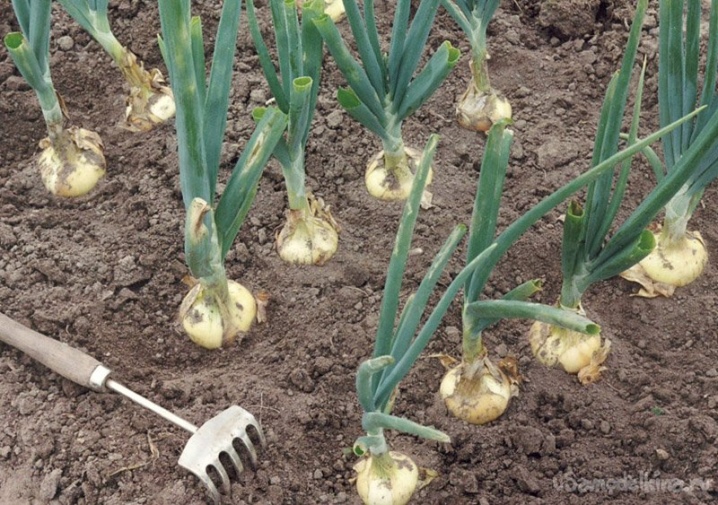
Irrigation methods
There are several ways to irrigate onions, but do not forget that for each period and for different planting of bulbs there is a different method.
- Irrigation with a watering can. This method is suitable for wetting green shoots, but it cannot be used for watering planting on turnips (drip or inter-row irrigation would be more suitable here).
- With a hose... A convenient way that has taken root among summer residents. In fact, you shouldn't water the onion like that. Firstly, because of the ice water, and secondly, because of the aggressive flow, which is able to wash off the bulb or damage the root.
- Drip irrigation. The most gentle method in which water enters the root system immediately. It has a positive effect on any type of sowing.
- Inter-row irrigation. To implement this method, small depressions are dug near the beds and filled with water. Thus, the root system of the plant is saturated with moisture. True, this method has one drawback - the top layer of the earth will have to be constantly loosened.

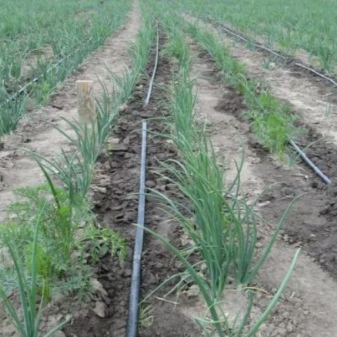
Useful Tips
A few great tips from experienced gardeners will definitely make the harvest richer and the onions tastier.
What kind of soil to plant onions also matters. Dry and sandy ground immediately means failure. The harvest, perhaps, will be, only very poor... The soil should be well moistened, and the fertile layer of the earth should be deep enough. The soil must be constantly fertilized.Also, this plant loves flat, sunlit places. A slightly acidic soil is most suitable.
After each moistening of the soil, it is not necessary, but it is recommended that a not very deep loosening is carried out., about two and a half centimeters deep, especially if the onion grows on loamy or clay soil, otherwise the beds can be buried under a strong layer of an impenetrable shell. It does not allow air to pass into the ground, to the roots, which makes the plant's ability to absorb nutrients into itself noticeably worse. Together with loosening, gardeners are weeding the beds.


It is worth noting that by pouring the onion with the drip method, you can safely forget about the loosening process.
As mentioned above, the best time to water onions is in the evening or morning. Irrigation with water in the heat of such plants as onions and garlic, in the daytime under bright sunlight will lead to the loss of almost fifty percent of the moisture necessary for the plant, it will simply evaporate. This is due to the type of onion, it grows vertically upward, and its feathers are thin sticks. All these factors will not create a sufficient effect in order to protect the surface of the earth from the incinerating rays of the sun.
To get more crops, experienced gardeners give advice: start a notebook and draw a small graph in it, with which you can water root crops in the open field and loosening on a schedule. Thus, the earth will never be dry, and it can always be saturated with oxygen.
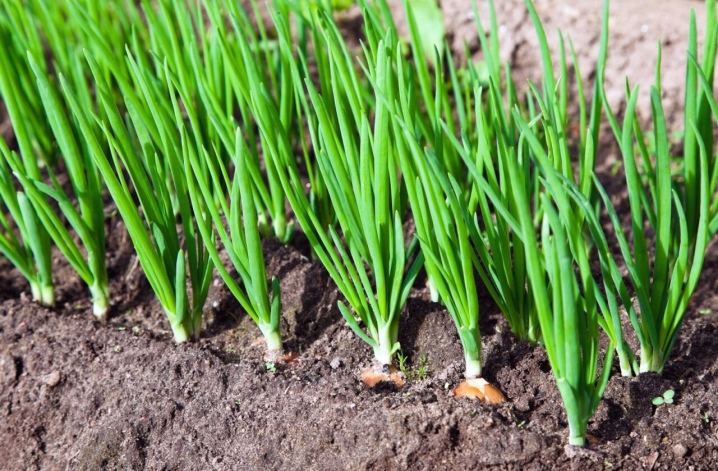
For information on how to water onions, see the next video.













The comment was sent successfully.